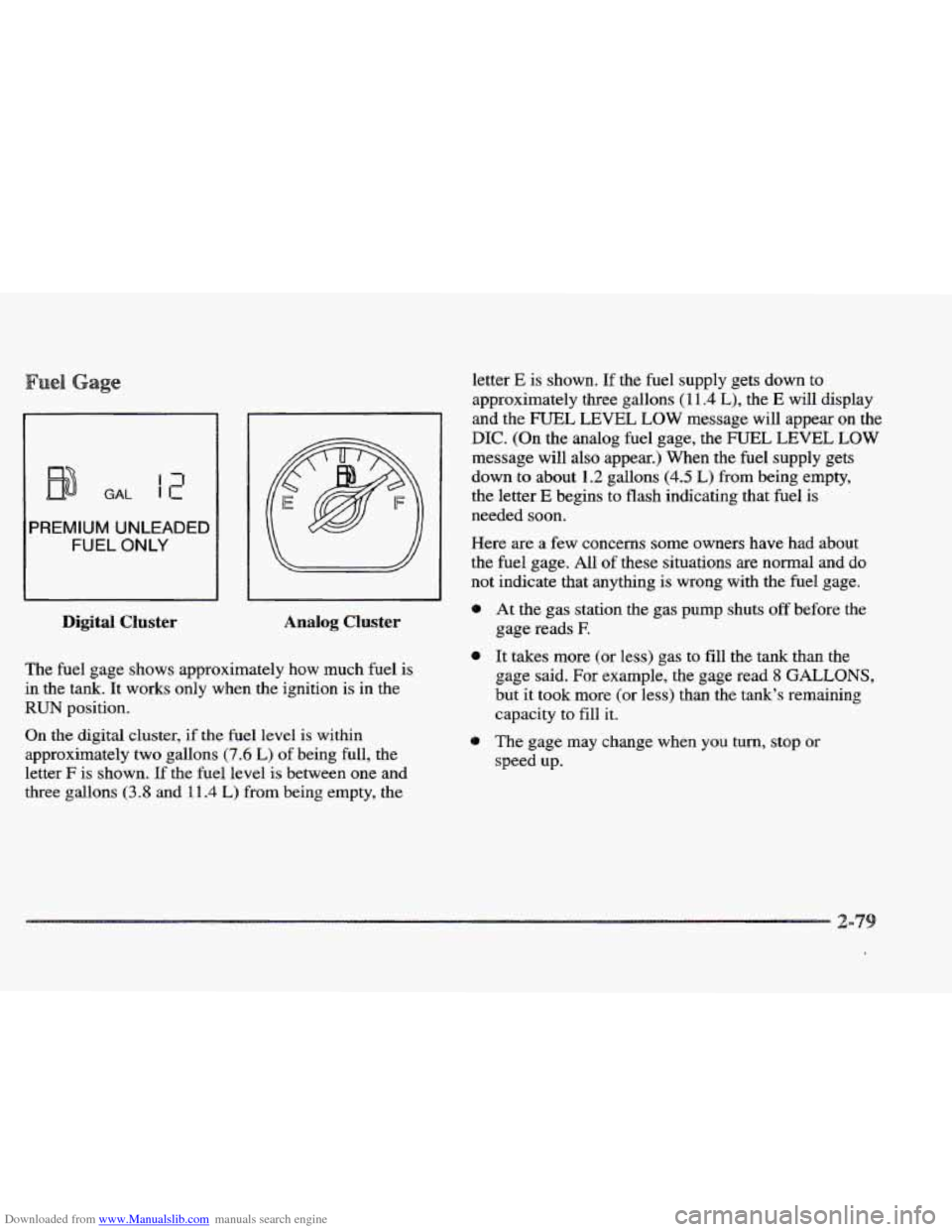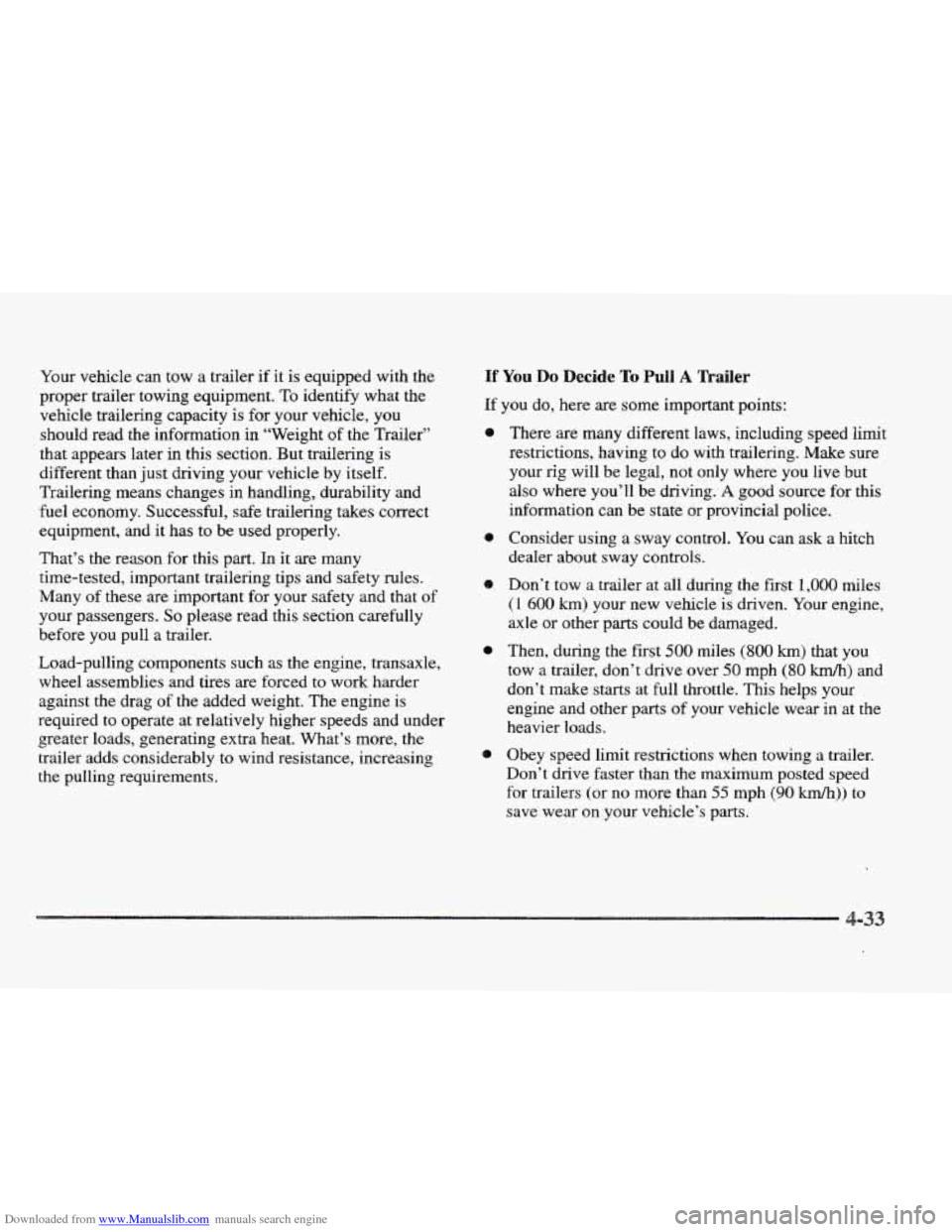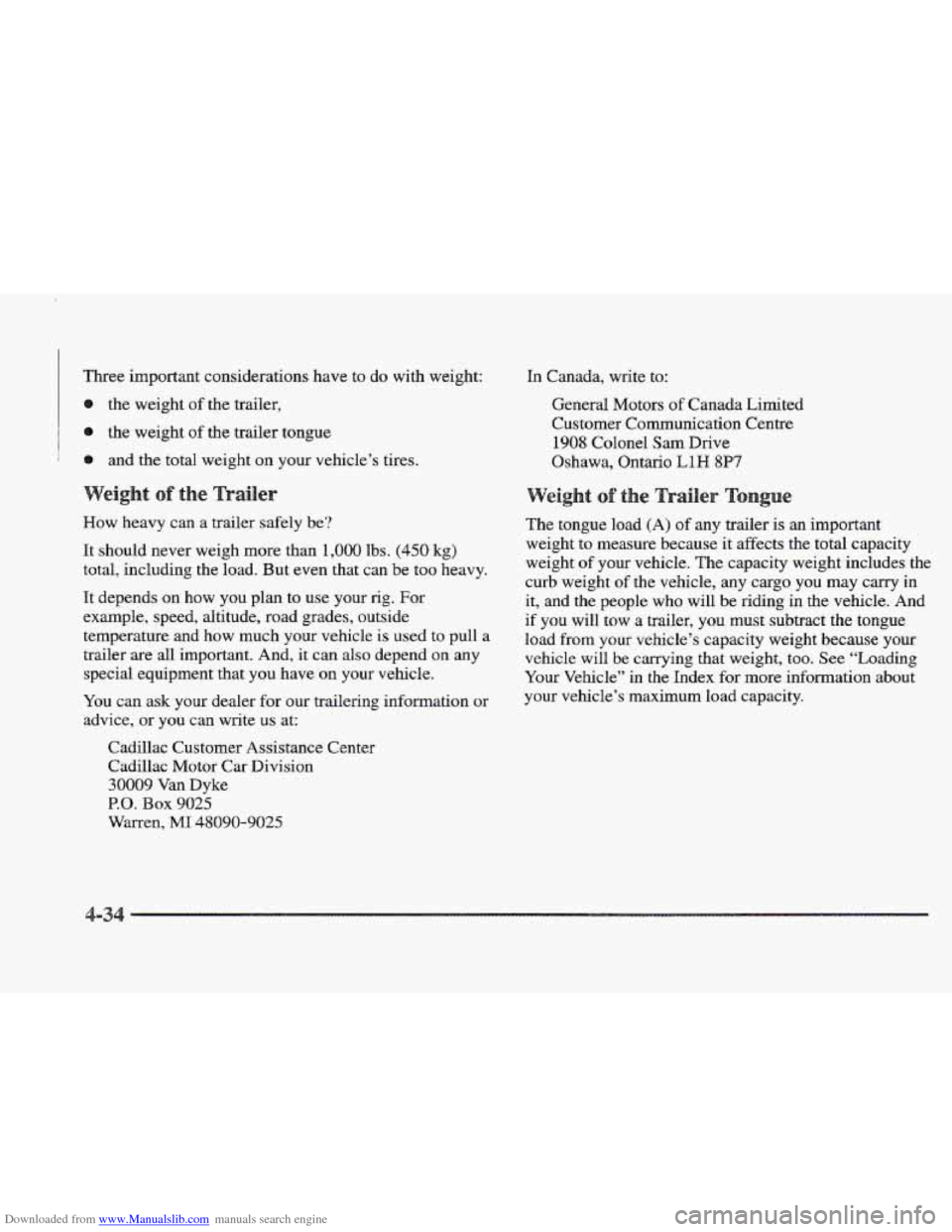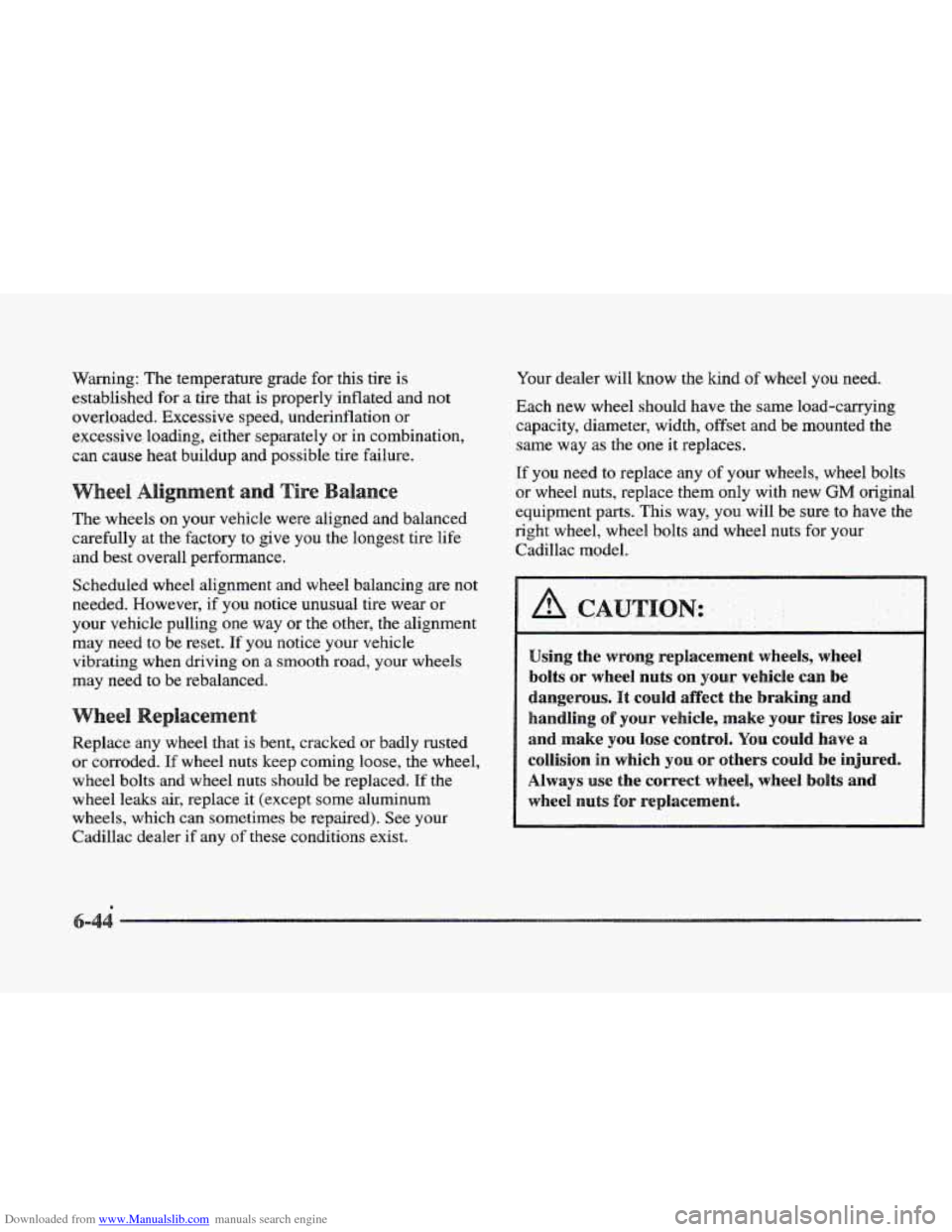1997 CADILLAC ELDORADO load capacity
[x] Cancel search: load capacityPage 142 of 361

Downloaded from www.Manualslib.com manuals search engine 13
GAL 11-
PREMIUM UNLEADED
FUEL ONLY
Digital Cluster
letter E is shown. If the fuel supply gets down to
approximately three gallons
( 1 1.4 L), the E will display
and the FUEL LEVEL LOW message will appear on the
DIC. (On the analog fuel gage, the FUEL LEVEL LOW
message will also appear.) When the fuel supply gets
down to about
1.2 gallons (4.5 L) from being empty,
the letter
E begins to flash indicating that fuel is
needed soon.
Here are a few concerns
some owners have had about
the fuel gage. All of these situations are normal
and do
not indicate that anythmg is wrong with the fuel gage.
I
0 At the gas station the gas pump shuts off before the
Analog Cluster gage reads E
The fuel gage shows approximately how much fuel is
in the tank. It works only when the ignition is in the
RUN position.
On the digital cluster, if the fuel level is within
approximately two gallons
(7.6 L) of being full, the
letter
F is shown. If the fuel level is between one and
three gallons
(3.8 and 111.4 L) from being empty, the
0 It takes more (or less) gas to fill the tank than the
gage said. For example, the gage read
8 GALLONS,
but it took more (or less) than the tank’s remaining
capacity to fill it.
0 The gage may change when you turn, stop or
speed up.
Page 215 of 361

Downloaded from www.Manualslib.com manuals search engine Run your engine 'only as long'as you must. This saves
fuel. When you run the engine, make it go a little faster
than just idle. That is, push the accelerator slightly.
This
uses less fuel for the-heat that you get and it keeps the
battery charged.
You will need a well-charged battery to
restart the vehicle, and.possibly.for signaling
later on
with your headlamps. Let-the heater
run for awhile.
Then, shut'the ,engine
off 'and close the window almost
all the way to preserve the heat.
Start the engine again
and repeat this only when you feel really uncornfortable
from the cold. But do it as little
as possible. Preserve the
fuel as long as you can. To help keep warm, you can get
out of the vehicle and
do some fairly vigorous exercises
every half hour or
so until help comes.
.- . ,* . . _.
oading Your Ve
;" 1.
TIRE-LOA.DING INFORMATION
OCCUPANTS VEHICLE
CAP. WT.
FRT. CTR. RR. TOTAL LBS. KG
MAX. LOADING & GWR SAME AS VEHICLE
CAPACITY WEIGHT XXX COLD TIRE
TIRE SIZE SPEED PRESSURE
RTG
PSVKPa
FRT.
RR.
SPA.
IF TIRES ARE HOT, ADD 4PSV28KPa
SEE OWNER'S MANUAL FOR ADDITIONAL
. INFORMATION
Two labels on your.vehicle show how much weight it
may properly
carry. The Tire-Loading Information label
found
on the driver's door tells you the proper size,
speed rating and recommended inflation pressures for
the tires on your vehicle. It also gives you important
infomation
about the number of people that can be in
your vehicle and the total weight that you can carry.
This weight is called the Vehicle Capacity Weight and
includes the weight of all occupants, cargo and all
options not installed in the factory.
Page 216 of 361

Downloaded from www.Manualslib.com manuals search engine MFD BY GENERAL MOTORS, CORP
DATE GVWR GAWR FRT GAWR RR
THIS VEHICLE CONFORMS TO ALL APPLI-
CABLE
U.S. FEDERAL MOTOR VEHICLE
SAFETY, BUMPER, AND THEFT PREVENTION
STANDARDS
IN EFFECT ON THE DATE OF
MANUFACTURE SHOWN ABOVE.
The other label is the Certification label, found on the
rear edge
of the driver’s door. It tells you the gross
weight capacity of your vehicle, called the GVWR
(Gross Vehicle Weight Rating). The GVWR includes the
weight of the vehicle, all occupants, fuel and cargo.
Never exceed the
GVWR for your vehicle, or the Gross
Axle Weight Rating
(GAWR) for either the front or
rear axle.
If you do have a heavy load, you should spread it out.
Don’t carry more than
176 lbs. (80 kg) in your trunk.
Do not load your vehicle any heavier than the
GVWR, or either the maximum front or rear
GAWR. If YOU do, parts on your vehicle can
break, or it can change the way your vehicle
handles. These could cause you
to lose control.
Also, overloading can shorten the life
of
your vehicle.
Your warranty does not cover parts or
components that fail because of overloading.
If you put things inside your vehicle -- like suitcases,
tools, packages, or anything else -- they will go as fast
as the vehicle goes. If you have to stop OF turn quickly,
or if there is a crash, they’ll keep going.
Page 218 of 361

Downloaded from www.Manualslib.com manuals search engine Your vehicle can tow a trailer if it is equipped with the
proper trailer towing equipment.
To identify what the
vehicle trailering capacity is for your vehicle,
you
should read the information in “Weight of the Trailer”
that appears later in this section. But trailering is
different than just driving your vehicle by itself.
Trailering means changes in handling, durability and
fuel economy. Successful, safe trailering
takes correct
equipment, and
it has to be used properly.
That’s the reason for this part. In
it are many
time-tested, important trailering tips and safety rules.
Many of these are important
for your safety and that of
your passengers.
So please read this section carefully
before you pull
a trailer.
Load-pulling components such
as the engine, transaxle,
wheel assemblies and tires are forced
to work harder
against the drag of the added weight. The engine is
required to operate at relatively higher speeds and under
greater loads, generating extra heat. What’s more, the
trailer adds considerably to wind resistance, increasing
the pulling requirements.
If You Do Decide TQ Pull A Trailer
If you do, here are some important points:
8
9
9
8
There are many different laws, including speed limit
restrictions, having to
do with trailering. Make sure
your rig will be legal, not only where you live but
also where you’ll be driving.
A good source for this
information can be state or provincial police.
Consider using a sway control.
You can ask a hitch
dealer about sway controls.
Don’t tow a trailer at all during the first
1,000 miles
(1 600 km) your new vehicle is driven. Your engine,
axle or other parts could be damaged.
Then, during
the first 500 miles (800 km) that you
tow a trailer, don’t drive over
50 mph (80 kmk) and
don’t make starts at full throttle. This helps your
engine and other
parts of your vehicle wear in at the
heavier loads.
Obey speed limit restrictions when towing
a trailer.
Don’t
drive faster than the maximum posted speed
for trailers (or no more than 55 mph (90 km/h)) to
save wear
on your vehicle’s parts.
Page 219 of 361

Downloaded from www.Manualslib.com manuals search engine Three important considerations have to do with weight:
the weight
of the trailer,
the weight
of the trailer tongue
and the total weight on your vehicle’s tires.
How heavy can a trailer safely
be?
It should never weigh more than 1,000 lbs. (450 kg)
total, including the load. But even that can be too heavy.
It depends on
how you plan to use your rig. For
example, speed, altitude, road grades, outside
temperature and
how much your vehicle is used to pull a
trailer are all important. And, it can also depend on any
special equipment that you have on your vehicle.
You can ask your dealer for our trailering information or
advice, or you can write us at:
Cadillac Customer Assistance Center
Cadillac Motor Car Division
30009 Van Dyke
P.O. Box 9025
Warren, MI 48090-9025
In Canada, write to:
General Motors of Canada Limited
Customer Communication Centre
1908 Colonel Sam Drive
Oshawa, Ontario
LlH 8P7
e
The tongue load (A) of any trailer is an important
weight to measure because it affects the total capacity
weight
of your vehicle. The capacity weight includes the
curb weight
of the vehicle, any cargo you may carry in
it, and the people who will be riding in the vehicle. And
if you will tow a trailer, you must subtract the tongue
load
from your vehicle’s capacity weight because your
vehicle will
be carrying that weight, too. See “Loading
Your Vehicle” in the Index for more information about
your vehicle’s maximum load capacity.
Page 274 of 361

Downloaded from www.Manualslib.com manuals search engine en t
If the oil is at or below the ADD line, then you’ll need
to add at least one quart of oil. But you must use the
right kind.
This part explains what kind of oil to use. For
crankcase capacity, see “Capacities and Specifications”
in the Index.
Pull out the dipstick and clean it with a paper towel or
cloth, then push it back in all the way. Remove it again,
keeping the tip down,
and check the level.
Page 307 of 361

Downloaded from www.Manualslib.com manuals search engine Warning: The temperature grade for this tire is
established for a tire that is properly inflated and not
overloaded. Excessive speed, underinflation
or
excessive loading, either separately or in combination,
can cause heat buildup and possible tire failure.
The wheels on your vehicle were aligned and balanced
carefully at the factory to give you the longest
tire life
and best overall performance.
Scheduled wheel alignment and wheel balancing are not
needed. However, if you notice unusual tire wear
or
your vehicle pulling one way or the other, the alignment
may need to be reset.
If you notice your vehicle
vibrating when
driving on a smooth road, your wheels
may need to be rebalanced.
Replace any
wheel that is bent, cracked or badly rusted
or corroded.
If wheel nuts keep coming loose, the wheel,
wheel bolts and wheel nuts should be replaced.
If the
wheel leaks air, replace
it (except some aluminum
wheels, which can sometimes be repaired). See
your
Cadillac dealer if any of these conditions exist. Your
dealer will know the kind of wheel you need.
Each new wheel should have the same load-carrying
capacity, diameter, width, offset and be mounted the
same way
as the one it replaces.
If you need to replace any of your wheels, wheel bolts
or wheel nuts, replace them only with new GM original
equipment parts. This
way, you will be sure to have the
right wheel, wheel bolts and wheel nuts for your
Cadillac model.
Using the wrong replacement wheels, wheel
bolts or wheel nuts on your vehicle can be
dangerous. It
could affect the braking and
handling
sf your vehicle, make your tires lose air
and make
YOU lose control. You could have a
c~llision in which you or others could be injured.
Always
use the correct wheel, wheel boats and
wheel nuts for replagment.